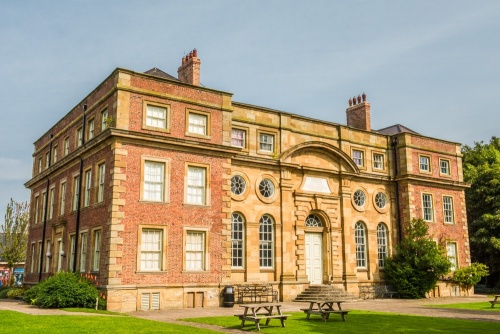
The Kirkleatham Museum is the local heritage museum for the Redcar and Cleveland borough. The museum is housed in the historic 18th-century Old Hall in Kirkleatham, a stunning early Georgian mansion.
History
The Hall was built in 1709 by Cholmley Turner, the great-nephew of Sir William Turner, who provided the money for the project. The younger Turner wanted to create a Free School for boys as an act of philanthropy.
The new Free School building was laid out in three bays; the central bay was the school, while the wings provided accommodation. One wing was reserved for the schoolmaster.

Sir William Turner lived in Kirkleatham Hall, almost directly opposite the Fre school. In addition to the school, he built almshouses and a hospital. The Free School is still in operation as Sir William Turner's 6th Form College, but in newer premises.
Cholmley Turner lavished money on Kirkleatham and added several other outstanding Georgian buildings including the Turner Mausoleum in the neighbouring church of St Cuthbert.
The former Free School building was transformed into a museum in 1981.

Museum Highlights
The Saxon Princess
Museum highlights include a large display of Anglo-Saxon objects, some dating to the 7th century. The star exhibit is the Saxon Princess Exhibition, based on an archaeological dig at the Street House Anglo-Saxon cemetery in Loftus that uncovered the grave of an unknown Saxon princess, buried on a wooden bed under an earthen mound. Finds in the grave included pottery, glass beads, a gold pendant, belt buckles, and iron knives.
The grave site was discovered when aerial photography showed the existence of a large Iron Age enclosure. When archaeologists examined the site they found over 100 separate burials.
See a recreation of a Saxon village, showing how people lived. Children will enjoy dressing up in Saxon clothing.

World War I
This exhibit looks at the First World War by examining the lives of local people who lived _ and died _ during the conflict.
Steel Stories
This exhibit covers the industrial heritage of Redcar and Cleveland, especially the steel industry. An interactive exhibit, based on real-world experiences of the people who lived and worked here. Listen to stories told by steelworkers, see mining artefacts, and trace the history of the iron and steel industry on Teesside for the last 170 years.
Gertrude Bell
Bell, who grew up in Redcar, was a world-famous traveller, archaeologist, and explorer, and a friend of fellow explorer TE Lawrence (Lawrence of Arabia). Though she was born into a wealthy family she chose to forgo a life of luxury and spent her life living and exploring the Middle East.
During WWI her knowledge of the region made her vital to the British Government. She took part in the creation of Iraq after the collapse of the Ottoman Empire. The exhibit looks at her remarkable life and career.

The museum also looks at the story of ironstone mining in Redcar and Cleveland, as well as exhibits covering social history, and maritime history.
In the museum grounds is the Kirkleatham Owl and Endangered Species Centre, home to one of the largest collections of owls in Britain. also in the grounds is the Sir James Knott Lifeboat Museum.
Kirkleatham Village
It is well worth taking a stroll around Kirkleatham village, which boasts a wonderful array of Georgia buildings, several of them listed Grade I or Grade II* for their heritage interest. Across the road from the Museum is Sir William Turner’s Hospital and Chapel (aka the almshouses), built in 1676 to provide accommodation for 20 elderly residents and 20 orphaned children.

Further along the road is St Cuthbert's Church built in 1763. The church stands on a site that was used for burials since the 9th century. A stone Viking coffin stands inside the church. Further on is the toasting Gate, once a garden feature in the grounds of Kirkleatham Hall (now vanished). From the gate, an old carriage drive leads to the eye-catching stable block, all that remains of the Hall.
Kirkleatham also boasts a terrace of railway cottages, even though it has never had a railway. The cottages were built in 1847 in Redcar, but moved to Kirkleatham when the railway line was extended in 1861.
Getting There
Kirkleatham Museum is just off the A174 Parkway. There is a large, free car park beside the museum. Buses 81, 81A, 707, and 63 service Kirkleatham village.
About Kirkleatham Old Hall Museum
Address: Kirkleatham Hall,
Kirkleatham,
Cleveland,
England, TS10 5NW
Attraction Type: Museum
Location: Off the A174 Parkway. Free on-site parking.
Website: Kirkleatham Old Hall Museum
Email: enjoy@redcar-cleveland.gov.uk
Location
map
OS: NZ592216
Photo Credit: David Ross and Britain Express
HERITAGE
 We've 'tagged' this attraction information to help you find related historic attractions and learn more about major time periods mentioned.
We've 'tagged' this attraction information to help you find related historic attractions and learn more about major time periods mentioned.
Find other attractions tagged with:
NEARBY HISTORIC ATTRACTIONS
Heritage Rated from 1- 5 (low to exceptional) on historic interest
Zetland Lifeboat Museum and Redcar Heritage Centre - 2.4 miles (Museum) ![]()
Guisborough, St Nicholas Church - 3.7 miles (Historic Church) ![]()
Gisborough Priory - 3.8 miles (Abbey) ![]()
Skelton-in-Cleveland Old Church - 4.1 miles (Historic Church) ![]()
Ormesby Hall - 4.9 miles (Historic Building) ![]()
Roseberry Topping - 5.7 miles (Countryside) ![]()
Captain Cook Birthplace Museum - 5.8 miles (Museum) ![]()
Captain Cook Schoolroom Museum - 7 miles (Museum) ![]()
Nearest Holiday Cottages to Kirkleatham Old Hall Museum:
Marske-by-the-Sea, Yorkshire
Sleeps: 6
Stay from: £570 - 1904
Marske-by-the-Sea, Yorkshire
Sleeps: 4
Stay from: £334 - 1012
More self catering near Kirkleatham Old Hall Museum










